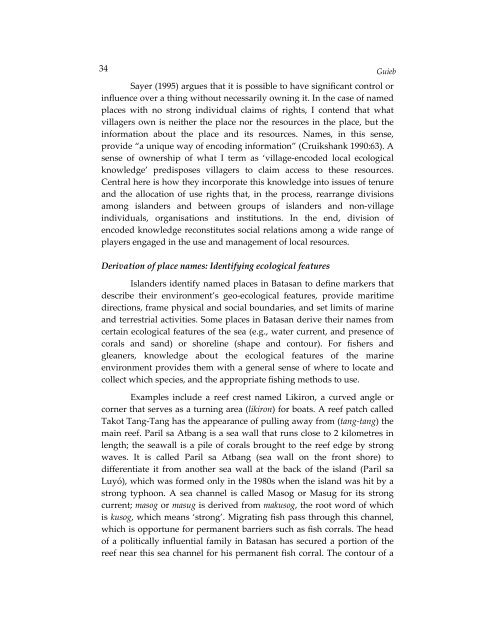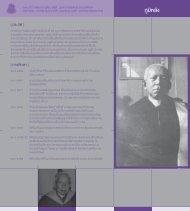34 GuiebSayer (1995) argues that it is possible to have significant control orinfluence over a thing without necessarily owning it. In the case of namedplaces with no strong individual claims of rights, I contend that whatvillagers own is neither the place nor the resources in the place, but theinformation about the place and its resources. Names, in this sense,provide “a unique way of encoding information” (Cruikshank 1990:63). Asense of ownership of what I term as ‘village-encoded local ecologicalknowledge’ predisposes villagers to claim access to these resources.Central here is how they incorporate this knowledge into issues of tenureand the allocation of use rights that, in the process, rearrange divisionsamong islanders and between groups of islanders and non-villageindividuals, organisations and institutions. In the end, division ofencoded knowledge reconstitutes social relations among a wide range ofplayers engaged in the use and management of local resources.Derivation of place names: Identifying ecological featuresIslanders identify named places in Batasan to define markers thatdescribe their environment’s geo-ecological features, provide maritimedirections, frame physical and social boundaries, and set limits of marineand terrestrial activities. Some places in Batasan derive their names fromcertain ecological features of the sea (e.g., water current, and presence ofcorals and sand) or shoreline (shape and contour). For fishers andgleaners, knowledge about the ecological features of the marineenvironment provides them with a general sense of where to locate andcollect which species, and the appropriate fishing methods to use.Examples include a reef crest named Likiron, a curved angle orcorner that serves as a turning area (likiron) for boats. A reef patch calledTakot Tang-Tang has the appearance of pulling away from (tang-tang) themain reef. Paril sa Atbang is a sea wall that runs close to 2 kilometres inlength; the seawall is a pile of corals brought to the reef edge by strongwaves. It is called Paril sa Atbang (sea wall on the front shore) todifferentiate it from another sea wall at the back of the island (Paril saLuyó), which was formed only in the 1980s when the island was hit by astrong typhoon. A sea channel is called Masog or Masug for its strongcurrent; masog or masug is derived from makusog, the root word of whichis kusog, which means ‘strong’. Migrating fish pass through this channel,which is opportune for permanent barriers such as fish corrals. The headof a politically influential family in Batasan has secured a portion of thereef near this sea channel for his permanent fish corral. The contour of a
Place Names, Seascape and Cartography of Marine Rightsreef crest, called Mailok—shaped like an armpit (ilok)—also provides asuitable location for fish corrals. One male elderly of Batasan describedthis place as an area believed by some residents of Batasan as home tosmall sharks that guard precious pearls that thrive aplenty underwater.At the time of field research, a village council member, who is a son of theowner of the fish corral on Masog, had claimed a portion of Mailok for histwo permanent fish corrals, which he uses alternately depending on themonsoon winds. Like all fish corral owners, he pays the annual permitfees at the municipal fisheries office. Hence, he enjoys some form ofterritorial control on portions of the fishing ground, one of which is todisallow some types of fishing that tend to limit the entry of fish into hisfish corral. A fish corral is an example of a device that informs fishers ofthe owner’s jurisdiction over the territory and the presence of certainfishing restrictions near the site. I discuss in the latter part of this essay aconflict involving two families that resulted from alleged violations onfishing restrictions near this type of fishing structure.Because of the presence of good corals, Mailok is also preferred bygleaners and various types of fishers: spear fishers (mamanaay); drive-innet fishers (manikbungay); fishers using traps and pots to catch wrasses(manimingay); gill net fishers targeting big fish species (mamokotay pokotpanagko); lantern fishers collecting sea cucumbers and seahorses (manoayor manugaay); and collectors of tropical fish (manimilyaay), giant clams,and the highly valued Noble Tugonia shells (manambayang). Many namedplaces in Batasan with reef features similar to Mailok are consideredeconomically important fishing grounds by villagers from Batasan andnearby islands.Places are also named based on the extent or depth of fishinggrounds and various parts of the reef environment. Most of Batasan’sfishing grounds, such as shoals (awo or awong), crests and reef patches, arenamed using this system. Examples include Awo Dako (Big Shoal), Awosa Tunghaon Mabaw (shallow shoal at Tunghaon), Awo sa TunghaonLawom (deep shoal at Tunghaon), Kanjaru Mabaw (Shallow Kanjaru),Kanjaru Lawom (Deep Kanjaru), Kaungan Dako (Big Kaungan),Maybanak Dako (Big Maybanak), and Maybanak Gamay (SmallMaybanak).I must emphasise a few points about some of these shoals. Awo saKaungan used to be a favourite site of blast fishers from Batasan andnearby islands such as Coameng, Hambungan, Mocaboc and Bilangbilangan.‘Way tuog ang isda diri sa una (Fish never got a chance to sleep or35
- Page 2 and 3: Hukay is a Tagalog term that can ei
- Page 5 and 6: ContentsiForeword1 Comets, Cults, a
- Page 7 and 8: iForewordHukay Volume 17 contains f
- Page 9 and 10: Comets, Cults, and Coins:A material
- Page 11 and 12: Comets, Cults, and Coins 3the mater
- Page 13 and 14: Comets, Cults, and Coins 5questioni
- Page 15 and 16: Comets, Cults, and Coins 7historica
- Page 17 and 18: Comets, Cults, and Coins 9authority
- Page 19 and 20: Comets, Cults, and Coins 11arisen e
- Page 21 and 22: Comets, Cults, and Coins 13This bea
- Page 23 and 24: Comets, Cults, and Coins 15This clo
- Page 25 and 26: Comets, Cults, and Coins 17Figure 6
- Page 27 and 28: Comets, Cults, and Coins 19perspect
- Page 29: Comets, Cults, and Coins 21Rochberg
- Page 32 and 33: 24Guiebexploratory visit to Batasan
- Page 34 and 35: 26looks into how certain claims to
- Page 36 and 37: 28Guieblocated off northwestern Boh
- Page 38 and 39: 30 Guieb(PAWB 2004). The NIPAS Act
- Page 40 and 41: 32 Guiebwho come to their reef. The
- Page 44 and 45: 36Guiebrest in this site)’ was ho
- Page 46 and 47: 38 Guiebisland, which is also calle
- Page 48 and 49: 40 Guiebof their marine environment
- Page 50 and 51: 42 Guiebestablishment of an MPA on
- Page 52 and 53: 44 Guiebconservation. Village-encod
- Page 54 and 55: 46 Guiebharvest. Regardless of econ
- Page 56 and 57: 48 GuiebIn Batasan, sites with perm
- Page 58 and 59: 50 Guiebcorrals vulnerable to theft
- Page 60 and 61: 52 Guiebecology of marine conservat
- Page 62 and 63: 54 GuiebDios. 2006. Coastal Environ
- Page 64 and 65: 56 Guieb1918 manuscript. Manila: Th
- Page 66 and 67: 58 GuiebUmali, A. F. 1950. Guide to
- Page 69 and 70: Determination of Oriental Tradeware
- Page 71 and 72: Determination of Oriental Tradeware
- Page 73 and 74: Determination of Oriental Tradeware
- Page 75 and 76: Determination of Oriental Tradeware
- Page 77 and 78: Determination of Oriental Tradeware
- Page 79 and 80: Determination of Oriental Tradeware
- Page 81 and 82: Determination of Oriental Tradeware
- Page 83 and 84: Determination of Oriental Tradeware
- Page 85 and 86: Determination of Oriental Tradeware
- Page 87 and 88: Microlithic Sites of Mandla (Madhya
- Page 89 and 90: Microlithic Sites of Mandla 81compl
- Page 91 and 92: Microlithic Sites of Mandla 83Sites
- Page 93 and 94:
Microlithic Sites of Mandla 85offer
- Page 95 and 96:
Microlithic Sites of Mandla 87Figur
- Page 97 and 98:
Microlithic Sites of Mandla 89Some
- Page 99 and 100:
Microlithic Sites of Mandla 91group
- Page 101 and 102:
Microlithic Sites of Mandla 93Figur
- Page 103 and 104:
Microlithic Sites of Mandla 95admin
- Page 105 and 106:
Microlithic Sites of Mandla 97Neoli
- Page 107 and 108:
Microlithic Sites of Mandla 99Histo
- Page 109 and 110:
Microlithic Sites of Mandla 101evol
- Page 111 and 112:
Microlithic Sites of Mandla 103preh
- Page 113 and 114:
Microlithic Sites of Mandla 105asso
- Page 115 and 116:
Microlithic Sites of Mandla 107iws.
- Page 117:
Microlithic Sites of Mandla 109www.
- Page 120 and 121:
112Eusebioacross Southeast Asia and
- Page 122 and 123:
114archaeologists do not publish in
- Page 124 and 125:
116different language family (Austr
- Page 126 and 127:
118Eusebiosubject is not even the f
- Page 128 and 129:
120Eusebiojournals, the topic gaine
- Page 130 and 131:
122Eusebio125:175-192.Dolukhanov, P
- Page 132 and 133:
124ParrenoSoares, P., J. A. Trejaut
- Page 134 and 135:
126made by the public. Quantifying
- Page 136 and 137:
128MelendresPhilippines, some are r
- Page 138 and 139:
130Manalochanges in the organisatio
- Page 140 and 141:
132Manalodefeat a giant, and marry
- Page 142 and 143:
134Santamariaborn,” and may refer
- Page 144 and 145:
136home, accompanied by bursts of f
- Page 146 and 147:
138Reyescognates of each other? Is
- Page 148 and 149:
140have used important Southeast As
- Page 150 and 151:
142ReferencesSteinberg, D. J. (ed.)
- Page 152 and 153:
144the law would protect a child ev
- Page 154 and 155:
Wills, J. E. Jr. 2011. China and Ma



